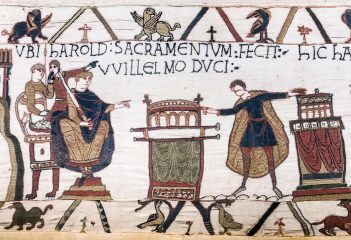The Bayeux Tapestry exhibit at UW Oshkosh wouldn’t have happened without Chancellor Andrew Leavitt.
Leavitt’s passion for the tapestry and his in-depth exploration of its history have made him an expert of sorts on the 230-foot long artistic rendering of the Norman Conquest of 1066.
Ask Chancellor Leavitt a question about the 950-year-old historic artwork and he’ll launch into elaborate explanations of its significance and little known facts about the linen canvas.
He has hunted down a 1966 copy of a National Geographic magazine that illustrates the tapestry panel by panel. He has a miniature version of the tapestry in fold-out paper format that he uses to educate the uninitiated on the masterpiece housed in Bayeux, France.
His fascination with this point in history and the tapestry began in the 1980s when he traced his ancestry to the Normans through research conducted in graduate school.
“I have no illusions we were part of the nobility,” he explained. “We were more likely peasants like everybody else.”
Like the intricate needlework that weaves vegetable-dyed woolen thread into the lavish piece of art, the tapestry is woven into Leavitt’s history. The campus where he accepted his first academic position, West Georgia College, had a partnership with Bayeux, France, and possessed a full-scale replica of the tapestry – this one acrylic paint on linen, but painstakingly reproduced to be true to the original. Leavitt became a champion of the replica tapestry. In 2004, he made his pilgrimage to France to see the original.
“It did not disappoint,” he said.
In 230-feet, the tapestry tells the story of battle, of chivalry, of the camaraderie that existed in the contemporary Middle Ages, Leavitt said. “It’s a wonderful glimpse back to what life was like in the 11th century.”
The tapestry is a visual account of the ascension of William as the first Norman king of England, the death of King Edward, the betrayal of Harold and the Battle of Hastings. The Battle of Hastings made England once more a part of Europe, something it had not been since the Roman Empire. The 1966 National Geographic article states 10,000 men were killed in the battle.
 Leavitt’s favorite panel depicts Duke William asking Harold to swear his allegiance to him.
Leavitt’s favorite panel depicts Duke William asking Harold to swear his allegiance to him.
The display of the replica tapestry at West Georgia was languishing and after Leavitt accepted a position at the University of North Georgia, plans were put in place by the man who had made the replica possible to move the tapestry there as well. When Leavitt moved to Oshkosh, he carried in the back of his mind a plan to bring the tapestry here on temporary exhibit.
North Georgia was more than willing to share its replica tapestry. And this month, Leavitt himself drove to Georgia to pick it up and bring it to Wisconsin.
“It’s a wonderful depiction of the intersection of art and history,” Leavitt said. “I know this is a reproduction, but it is also a piece of art that shows that history and art are accessible to anyone at any age.”
His hope is that people will take away an appreciation for the beauty and the mystery of the tapestry.
“Many people won’t get to France to see the tapestry, but they can see a very nice rendering of it here at UWO,” Leavitt said.
“I’m a scientist by training and some people will say ‘why would a scientist care about a piece of art or a piece of history?’” he said. “To me it’s just one of those rare objects where it all sort of comes together.”
Learn more:
